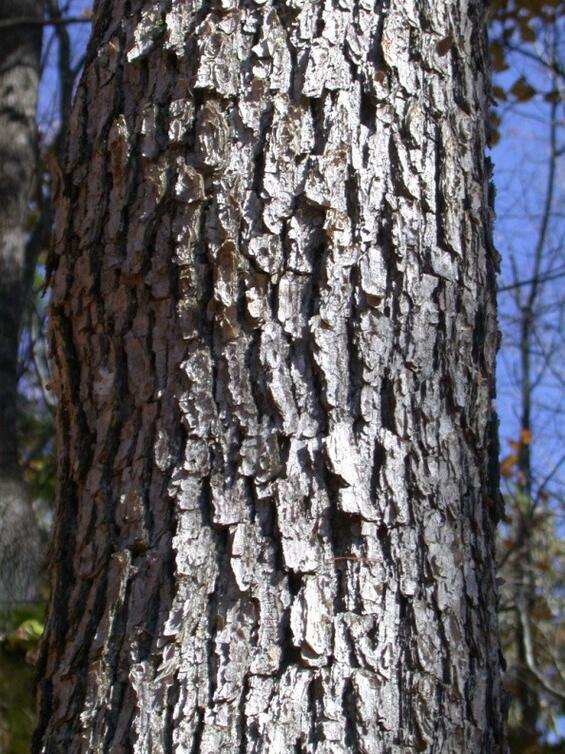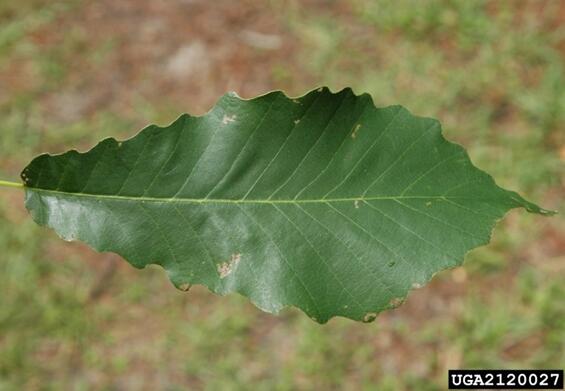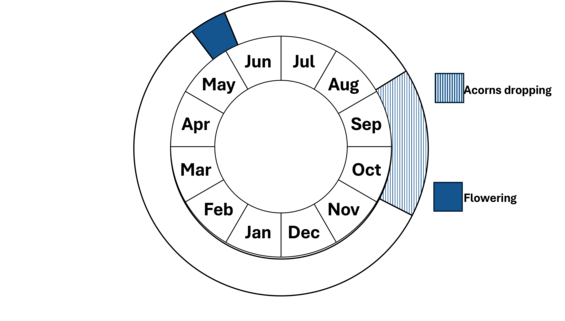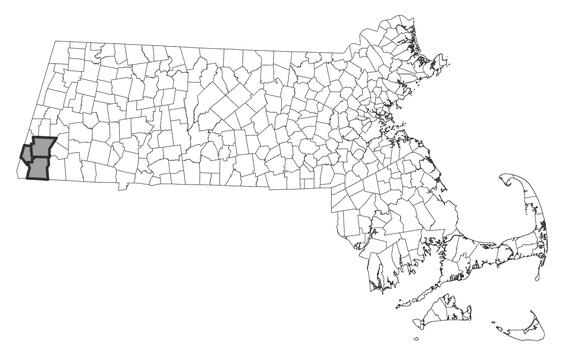- Scientific name: Quercus muehlenbergii Engelm
- Species of Greatest Conservation Need (MA State Wildlife Action Plan)
- Threatened (MA Endangered Species Act)
Description

Yellow Oak trunk showing flaky bark. Photo credit: Patricia Swain
Yellow oak, Quercus muehlenbergii, a member of the Beech family (Fagaceae) is a deciduous tree with alternately arranged leaves, twigs, and branches. It grows to a maximum height of approximately 30 m (about 100 ft) but only to 20 m (65 ft) in New England. It has dark gray, thin, flaky to papery bark. The leaves are toothed, either without lobes or with shallow lobes, narrowly ovate or slightly wider toward the top, densely pubescent beneath, with 9 to 14 veins on each side. Each vein runs straight (and parallel to one another) to a tooth, which itself is sharp, upward arching, and often incurved, and tipped with a minute projection or papilla. Acorns are borne singly or in pairs and are unstalked or with very short (8 mm; 0.3 inches or less) stalks. The acorn is up to 2.5 cm (1 in) long. It is enclosed up to one-half its length by a bowl-shaped cup. The acorns ripen in one growing season and seldom persist on the twig past October.
The genus Quercus in Massachusetts includes a large number of species. Among the most common native species are chestnut, white, red, black, scarlet, and swamp white oaks. Naturalists familiar with those and perhaps other less common oaks can distinguish yellow oak leaves from those of other oaks by their upward-arching and usually incurved, papilla-tipped teeth.

Yellow oak leaf. Photo credit: Chris Evans
Yellow oak leaves somewhat resemble those of chestnut oak (Quercus montana, formerly Q. prinus), swamp white oak (Q. bicolor), and dwarf chinkapin or scrub chestnut oak (Q. prinoides) except, however, for the upward arching and usually incurved papilla-tipped teeth. Additionally, dwarf chinkapin oak is shrub-like in habit and is usually found on acidic sands or dry shales.
Life cycle and behavior

Yellow oak usually flowers in New England from May 21 to June 8. Acorns mature in one growing season and drop from the tree in September and October. Like other members of the white oak group, acorns germinate shortly after dropping and require no cold stratification. Seed leaves or cotyledons remain below ground upon germination.
Population status
Yellow oak is listed under the Massachusetts Endangered Species Act as threatened. All listed species are protected from killing, collecting, possessing, or sale and from activities that would destroy habitat and thus directly or indirectly cause mortality or disrupt critical behaviors. This species has been reported at only ten locations, all in southern Berkshire County. While individual tree vigor at these sites is generally good, regeneration is erratic.
Distribution and abundance
Yellow oak is known across the eastern United States and into Ontario in Canada. It is known from Vermont to Minnesota (where it is possibly extirpated) south to Texas and New Mexico, and east to the Atlantic coast, Massachusetts to Florida. In New England, yellow oak is imperiled in Massachusetts, and as vulnerable in Connecticut and Vermont. It is not known in the other New England states.

Distribution in Massachusetts. 1999-2024. Based on records in the Natural Heritage Database.
Habitat
Yellow oak is almost always found on dry soils of pH greater than 6.0. Populations have been recorded on lime cobbles, a dry calcareous wood, a high domed rocky outcrop, and an east-facing ten-degree slope. Good populations are often indicators of yellow oak dry calcareous forests, a rare community in Massachusetts. Associated tree species found with yellow oak might include sugar maple (Acer saccharum), white oak (Q. alba), and black oak (Q. velutina), and possibly red oak (Q. rubra), white ash (Fraxinus americana), shagbark hickory (Carya ovata), pignut hickory (Carya glabra), white pine (Pinus strobus), and hemlock (Tsuga canadensis).
Healthy habitats are vital for supporting native wildlife and plants. Explore habitats and learn about conservation and restoration in Massachusetts.
Threats
Invasion by exotic species (both plant and animal), diseases, and logging are current or potential threats to all native tree species and yellow oak populations in Massachusetts are no exception. One population of yellow oak is currently threatened by invasion by oriental bittersweet (Celastrus orbiculatus). Spongy moth (Lymantria dispar) is one of several defoliating insects that can impact yellow oak. Yellow oak are shade intolerant and will be outcompeted by associated species such as sugar maple (Acer saccharum), depending on community composition. High deer densities can reduce the number of seedlings dramatically, thereby limiting recruitment to the sapling and canopy stages.
Conservation
Survey for yellow oak and assessments of its habitats is important to maintain it as part of the biodiversity of our state. The best time to survey for it is when leaves are present. Later in the season when the acorns are also present during September will help to conclusively identify the species. Yellow oak management might be to address invasive exotic species, proposed logging, or high deer densities and browse. All of these are important issues that need to be addressed for populations of yellow oak to thrive. All active management of rare plant populations (including invasive species removal) is subject to review under the Massachusetts Endangered Species Act and should be planned in close consultation with MassWildlife’s Natural Heritage & Endangered Species Program. Yellow oak populations often do not have a high recruitment rate. This may be the result of high deer browse, or another cause. Techniques to increase the number of young oaks in the populations need to be research. These might include deer exclusion fencing, cutting mature non-oak trees to allow more light to reach the forest floor, or something else.
References
NatureServe. 2025. NatureServe Network Biodiversity Location Data accessed through NatureServe Explorer [web application]. NatureServe, Arlington, Virginia. Available https://explorer.natureserve.org/. Accessed: 5/1/2025.
Sander, I.L. 1990. Chinkapin Oak. In Silvics of North America. U.S. Department of Agriculture, U.S. Forest Service Agricultural Handbook 654. Available via http://www.na.fs.fed.us/spfo/pubs/silvics_manual/table_of_contents.htm. Accessed January 17, 2010.
Tirmenstein, D. A. 1991. Quercus muehlenbergii. In: Fire Effects Information System, [Online]. U.S. Department of Agriculture, Forest Service, Rocky Mountain Research Station, Fire Sciences Laboratory (Producer).
Contact
| Date published: | May 12, 2025 |
|---|